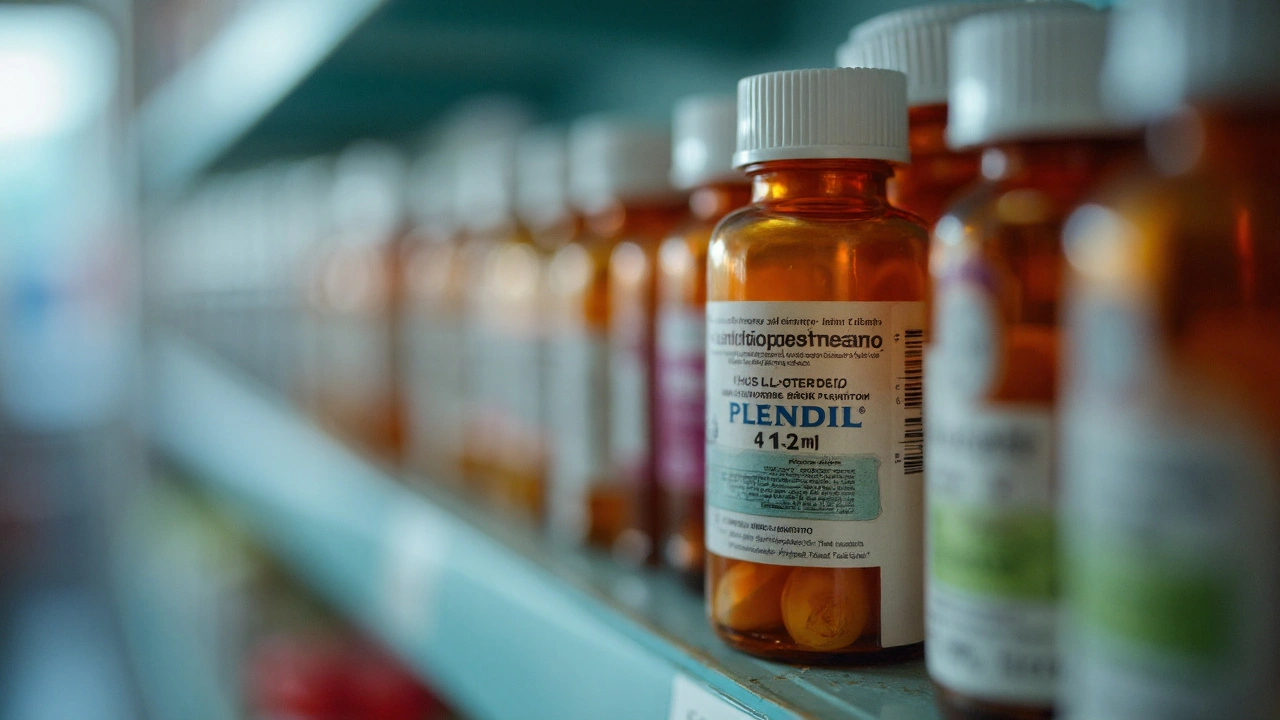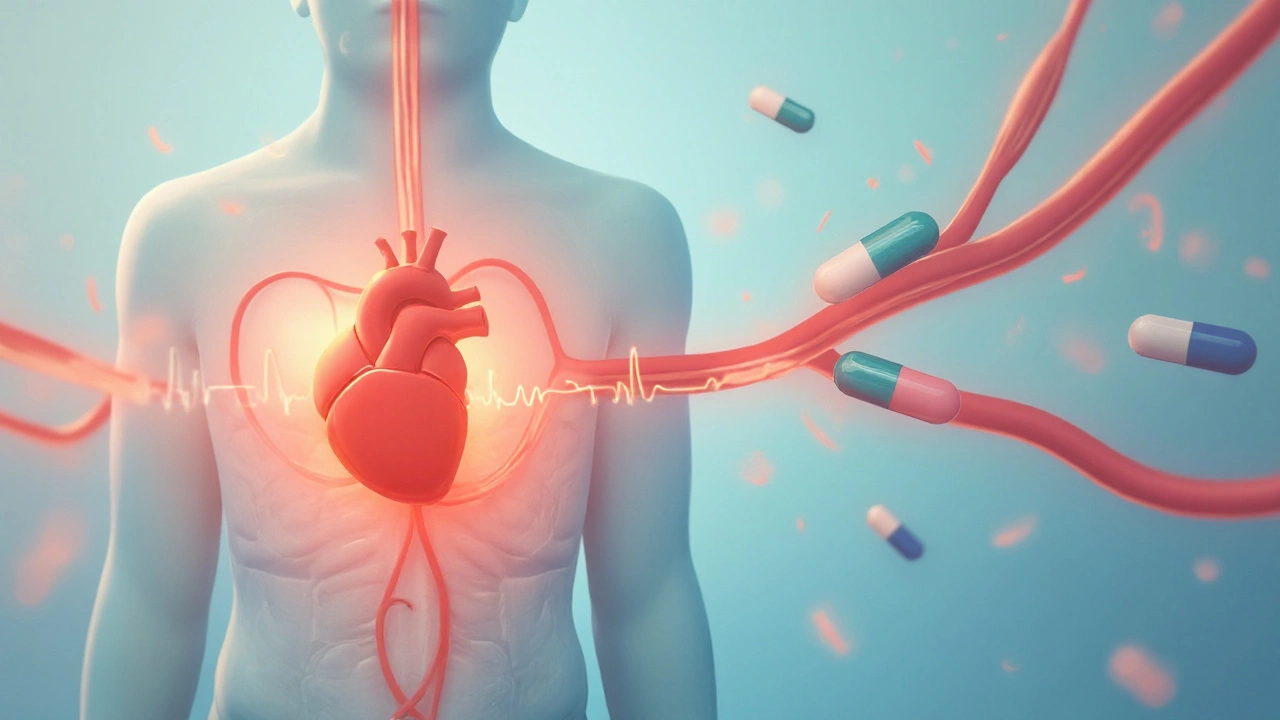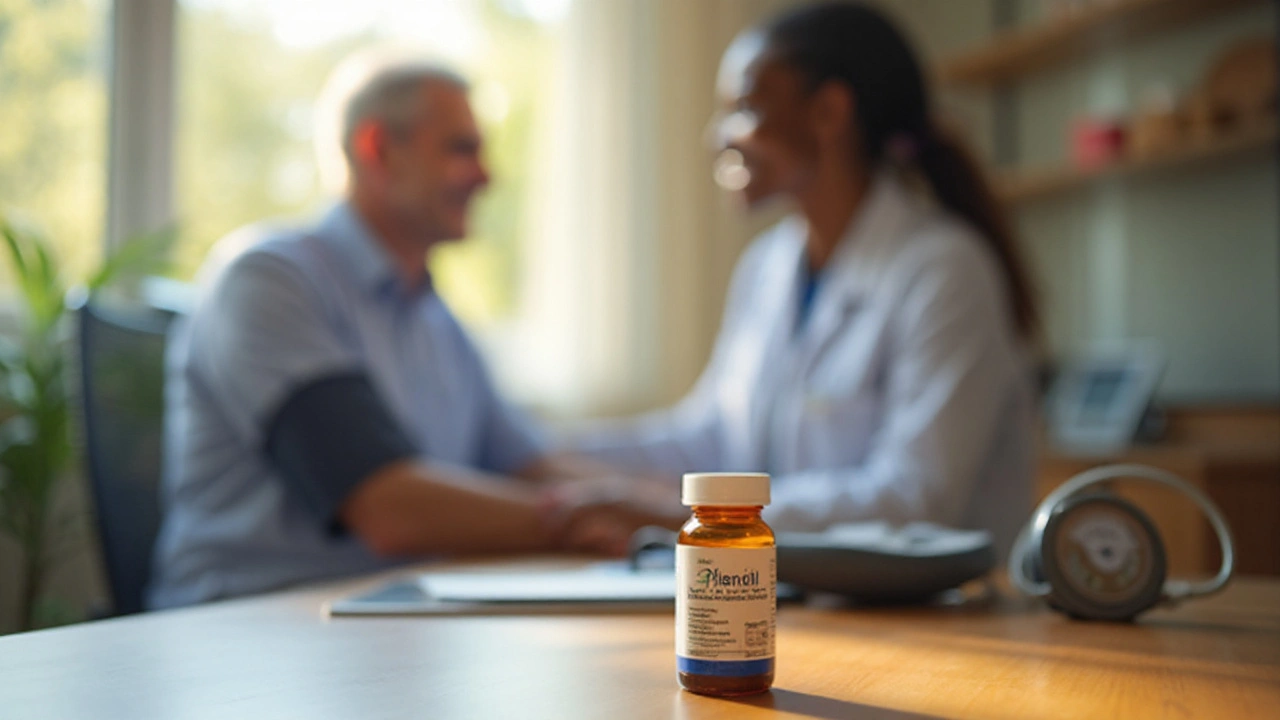Felodipine Suitability Quiz
1. What is your age?
2. What is your estimated glomerular filtration rate (eGFR) in mL/min?
3. Are you taking any strong CYP3A4 inhibitors (e.g., ketoconazole, erythromycin, grapefruit juice) regularly?
4. Do you have a history of significant peripheral edema?
Plendil is the brand name for felodipine, a third‑generation calcium channel blocker used to lower blood pressure. It works by relaxing the smooth muscles of arterial walls, reducing vascular resistance and easing the heart’s workload. Because it targets L‑type calcium channels more selectively than older drugs, patients often experience fewer reflex heart‑rate spikes.
How Felodipine Lowers Blood Pressure
Once absorbed, felodipine binds to the alpha‑1 subunit of L‑type calcium channels in vascular smooth‑muscle cells. This blocks calcium influx, which limits contraction and promotes vasodilation. The result is a drop in systolic and diastolic readings without a direct effect on heart rate. Clinical trials in the UK and Europe report an average reduction of 10‑12mmHg systolic after eight weeks of therapy.
Direct Comparisons with Other Calcium‑Channel Blockers
When you’re picking a CCB, the main choices are amlodipine, nifedipine, lercanidipine and benidipine. Below is a snapshot of how each stacks up against felodipine on the most practical parameters.
| Drug | Class | Typical Daily Dose | Half‑life (hours) | Common Side‑effects |
|---|---|---|---|---|
| Felodipine (Plendil) | 3rd‑gen Dihydropyridine | 5‑10mg | 20‑24 | Peripheral edema, flushing, headache |
| Amlodipine | 1st‑gen Dihydropyridine | 5‑10mg | 30‑50 | Edema, dizziness, gingival hyperplasia |
| Nifedipine | 1st‑gen Dihydropyridine | 30‑60mg (extended‑release) | 2‑5 | Reflex tachycardia, flushing, nausea |
| Lercanidipine | 3rd‑gen Dihydropyridine | 10‑20mg | 8‑10 | Headache, dizziness, mild edema |
| Benidipine | 3rd‑gen Dihydropyridine | 2‑8mg | 6‑8 | Dry mouth, constipation, peripheral edema |
Key take‑aways:
- Felodipine’s half‑life sits comfortably between the short‑acting nifedipine and the ultra‑long amlodipine, allowing once‑daily dosing with steady plasma levels.
- In terms of edema, felodipine and lercanidipine tend to cause less fluid retention than amlodipine, which can be a deciding factor for patients with heart‑failure risk.
- Benidipine offers additional T‑type calcium channel blockade, which may benefit patients with nocturnal hypertension, though it’s not widely available in the UK.
How Felodipine Compares to Other Antihypertensive Classes
Calcium‑channel blockers are only one piece of the hypertension puzzle. Physicians often pair them with ACE inhibitors, ARBs or thiazide diuretics. Below is a quick look at three widely prescribed alternatives.
Ramipril is an ACE inhibitor that blocks the conversion of angiotensin I to angiotensin II, leading to vasodilation and sodium excretion.ACE inhibitors are especially useful for patients with diabetic kidney disease, as they protect renal micro‑vasculature. Compared with felodipine, ramipril typically causes a milder drop in blood pressure but carries a risk of cough and rare angio‑edema.
Losartan is an angiotensin‑II receptor blocker (ARB) that blocks the same pathway downstream of the ACE step.Losartan is favored when patients can’t tolerate the ACE‑inhibitor cough. Its blood‑pressure effect is comparable to ramipril, but it doesn’t lower potassium as aggressively.
Hydrochlorothiazide is a thiazide diuretic that reduces plasma volume by increasing urinary sodium and water excretion.Thiazides are inexpensive and work well as add‑on therapy. However, they can raise uric acid and impair glucose tolerance-issues felodipine sidesteps.
When combining drugs, clinicians follow the "S‑shaped" strategy: start with a low‑dose CCB or ACE‑inhibitor, then add a thiazide if the target isn’t reached. This approach balances efficacy with tolerability.

Factors to Help You Choose the Right Blood‑Pressure Medicine
Deciding whether felodipine is the best fit depends on three practical factors.
- Age and comorbidities. Older adults often experience pronounced edema from CCBs; a shorter‑acting option like nifedipine or a low‑dose ACE inhibitor may be gentler.
- Renal function. If eGFR is below 30mL/min, thiazides lose potency, and a CCB such as felodipine becomes a safer backbone.
- Drug‑interaction profile. Felodipine is metabolised by CYP3A4. Strong inhibitors (e.g., erythromycin, ketoconazole) can raise serum levels, while inducers (e.g., rifampicin) may blunt its effect.
Ask your GP about these points during the consultation. A personalized plan often means a combination therapy rather than a single pill.
Managing Common Side‑effects of Felodipine
Even the most tolerable drugs can cause mild discomfort. Here’s how to keep the usual culprits-peripheral edema, flushing and headache-under control.
- Edema: Reduce sodium intake, wear compression stockings, and consider adding a low‑dose ACE inhibitor (which narrows capillaries) if swelling persists.
- Flushing: Take felodipine with food, avoid hot showers or sauna sessions right after dosing, and keep the bedroom cool.
- Headache: Hydrate well and limit caffeine. If headaches are daily, a brief trial of a short‑acting NSAID can break the cycle.
Any side‑effect that worsens or appears suddenly-like a persistent cough or severe dizziness-should trigger an immediate call to the prescriber.
Related Concepts: Drug Interactions and Metabolism
Understanding how felodipine interacts with other medicines helps you avoid surprises.
- CYP3A4 inhibitors (e.g., grapefruit juice, certain antifungals) can increase felodipine plasma concentrations by up to 50%. \n
- CYP3A4 inducers (e.g., St.John’swort, carbamazepine) may lower its effect, leading to uncontrolled blood pressure.
- Concurrent antihypertensives-especially other vasodilators-can cause additive hypotension; dose adjustments are usually needed.
Most clinicians recommend a medication review every six months, especially if you start a new over‑the‑counter product or supplement.
Practical Tips for Monitoring Your Blood Pressure on Felodil
Self‑monitoring empowers you to see how the drug works in real time.
- Buy a validated automatic cuff; wrist‑type devices are less accurate.
- Take readings at the same time each day-ideally morning before medication and evening after dinner.
- Record three consecutive measurements and calculate the average.
- Share the log with your GP after two weeks; dosage tweaks are based on trends, not a single outlier.
If you notice systolic values below 100mmHg or a sudden drop of more than 20mmHg, hold the next dose and inform your doctor.

Frequently Asked Questions
Can I take felodipine with a statin?
Yes, most statins (e.g., atorvastatin, rosuvastatin) do not share the same CYP3A4 pathway as felodipine, so they can be combined safely. Always check with your prescriber if you’re on a high‑dose simvastatin, as it is a stronger CYP3A4 substrate.
Is felodipine safe during pregnancy?
Animal studies have not shown major teratogenic effects, but human data are limited. The UK NICE guidelines advise using pregnancy‑category B drugs only when the benefit outweighs the risk, so most clinicians switch to labetalol or methyldopa during pregnancy.
Why does felodipine cause ankle swelling?
The drug relaxes arterial smooth muscle, which raises capillary hydrostatic pressure. Fluid then leaks into surrounding tissues, especially in the lower legs where gravity assists the buildup.
How long does it take for felodipine to lower my blood pressure?
Most patients see a measurable drop within one to two weeks, with the full effect reached after four to six weeks of consistent dosing.
Can I switch from amlodipine to felodipine?
Switching is possible, but it should be done under medical supervision. A typical conversion is 5mg amlodipine to 5mg felodipine, with close blood‑pressure monitoring for the first two weeks.
What should I do if I miss a felodipine dose?
Take the missed tablet as soon as you remember, unless it’s almost time for the next dose. In that case, skip the forgotten dose-don’t double‑dose.
Is there a generic version of Plendil?
Yes, the generic name felodipine is available in tablet form at a lower cost than the branded Plendil, and it offers the same pharmacokinetic profile.

Yo, i saw you read about felodipine and thought you might be missing the fact that it can mess with your sleep cycle if you take it late at nigth, also watch out for that grapefruit juice thing because it can blow up your dosage crazy.
Hey, no worries! 🌟 Just take felodipine with breakfast and keep the citrus juice away, and you’ll dodge most surprises. It works like a charm when you keep the routine steady.
Choosing the right blood‑pressure medicine can feel like navigating a maze, but remember that every path has its own signposts. Felodipine offers a smooth ride for many because of its balanced half‑life and selective action. If you’re under 65 and have decent kidney function, it often slides into place nicely. Older patients might notice a bit more swelling, but that can be managed with diet tweaks or an ACE inhibitor boost. The drug’s metabolism via CYP3A4 means you should double‑check any antifungal or antibiotic you’re taking. Even the occasional grapefruit juice can tip the scales, so moderation is key. Compared to amlodipine, felodipine tends to cause slightly less gingival hyperplasia, which is a win for oral health. On the flip side, nifedipine’s short half‑life can be a blessing for rapid titration but feels like a roller coaster for some. Lercanidipine is another third‑gen buddy that whispers rather than shouts, often giving lower edema rates. Benidipine adds a T‑type block, which might help nocturnal spikes if you can get it. Pairing felodipine with a low‑dose thiazide can tighten control without over‑loading any single mechanism. Keep an eye on your sodium intake; less salt can mute that pesky peripheral swelling. If you ever feel a headache linger, a gentle NSAID or adjusting the time of day you dose can smooth things out. And always keep a log of your readings-seeing trends over weeks beats a single freaky number. Lastly, stay in touch with your GP; their tweaks based on your lived data keep the therapy humming along.
Great rundown! Adding a low‑dose ACE inhibitor on top of felodipine often eases that ankle puffiness, and most folks tolerate the combo well.
Edema is the worst side effect.
While swelling can be discouraging, consider that the vascular dilation it signifies is precisely what lowers pressure; a measured approach with compression stockings often suffices.
Honestly, felodipine feels like a drama queen compared to amlodipine – it flares up with flushing and makes you feel like you’re on fire every time you walk past a hot stove! 😩
Let’s dial down the drama a bit. The flushing usually settles after the first two weeks; staying hydrated and avoiding hot baths can keep it in check.
One must observe that felodipine’s pharmacokinetic profile aligns with optimal adherence, provided the patient refrains from concurrent CYP3A4 inducers or inhibitors.
Sure, but most laypeople ignore those nuances and end up with sub‑therapeutic levels or toxic spikes. The average patient can’t even pronounce CYP3A4 correctly.
I completely understand how overwhelming it can feel when you’re sorting through all these medication options, especially when you’re already managing blood‑pressure concerns and possibly other health issues. It helps to take a step back and look at the big picture: your overall cardiovascular risk, any co‑existing conditions like diabetes or kidney disease, and how each drug class might address those factors. Felodipine, for instance, offers a steady reduction in systolic pressure without the strong reflex tachycardia you sometimes see with short‑acting agents. Yet, the peripheral edema it can cause may be a deal‑breaker if you have pre‑existing heart‑failure concerns. Pairing it with an ACE inhibitor often mitigates that swelling, which is why many clinicians prefer combination therapy. On the other hand, a thiazide diuretic is inexpensive and works well as an add‑on, but it can elevate uric acid and affect glucose tolerance – important considerations for patients with gout or metabolic syndrome. Ultimately, the best approach is a personalized one, guided by regular monitoring, open dialogue with your prescriber, and a willingness to adjust the regimen as your body responds. Keep a log of your readings, note any side‑effects, and bring that information to your next appointment; it’ll empower both you and your doctor to make informed tweaks.